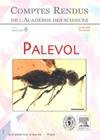来自罗马尼亚东喀尔巴阡山前缘晚中新世的 Chilotherium schlosseri (Weber, 1905) (犀牛科,哺乳纲
IF 1.3
4区 地球科学
Q3 PALEONTOLOGY
引用次数: 0
摘要
本文概述了罗马尼亚的 Chilotherium Ringström, 1924 年化石,这些化石目前记录在东喀尔巴阡山前缘三个不同的上新世地点:雷吉乌、巴卡乌和波加纳的哺乳动物地点。这些化石包括一个部分头骨、几块上颌骨和下颌骨碎片以及个别牙齿。这些化石已被部分图解,但除了波加纳的个别牙齿外,从未被描述过。以前的归属很混乱,从雷丘标本的 Chilotherium schlosseri(韦伯,1905 年)和 C. cf. sarmaticum,到接近 C. sarmaticum Korotkevich,1958 年的不确定物种、C. kiliasi(Geraads & Koufos,1990 年),以及波加纳牙齿的 C. kowalevskii(Pavlow,1913 年)。根据描述和与其他 Chilotherium 遗骸的比较,罗马尼亚的所有标本都可以归为 C. schlosseri。Chilotherium schlosseri 是该属中分布最广的物种,分布范围从东欧到中亚。该属在罗马尼亚以及更广泛的东欧地区的存在,证明了西欧(没有 Chilotherium 的地区)较为封闭和树木繁茂的环境与亚洲较为开阔的环境之间的过渡区域。本文章由计算机程序翻译,如有差异,请以英文原文为准。
Chilotherium schlosseri (Weber, 1905) (Rhinocerotidae, Mammalia) from the late Miocene of the foreland of the Eastern Carpathians in Romania
The paper provides an overview of the Chilotherium Ringström, 1924 fossils from Romania, which are recorded so far in three different Upper Miocene localities of the Eastern Carpathians Foreland: mammal localities of Reghiu, Bacău and Pogana. The fossils include a partial skull, several maxillary and mandible fragments and isolated teeth. They have been partially illustrated, but never described excepting the isolated teeth of Pogana. The previous assignments were confusing, ranging from Chilotherium schlosseri (Weber, 1905) and C. cf. sarmaticum for Reghiu specimens to an indeterminate species close to C. sarmaticum Korotkevich, 1958, C. kiliasi (Geraads & Koufos, 1990), and C. kowalevskii (Pavlow, 1913) for Pogana teeth. Based on descriptions and comparisons with other Chilotherium remains, all specimens from Romania can be referred to C. schlosseri. Chilotherium schlosseri is the most widespread species of the genus, ranging from Eastern Europe to Central Asia. The presence of this genus in Romania, and more globally in Eastern Europe, attests to a transition area between the more closed and wooded environments of Western Europe (where Chilotherium is absent) to the more open ones in Asia.
求助全文
通过发布文献求助,成功后即可免费获取论文全文。
去求助
来源期刊

Comptes Rendus Palevol
地学-古生物学
CiteScore
2.10
自引率
0.00%
发文量
39
审稿时长
17.6 weeks
期刊介绍:
Comptes Rendus Palevol is a fully electronic and peer-reviewed journal, with a continuous publication stream, devoted to palaeontology, prehistory and evolutionary sciences. It publishes original research results, in French or English, in the following domains: systematic and human palaeontology, prehistory, evolutionary biology and macroevolution, and history of sciences. Thematic issues may also be published under the responsibility of a guest editor. All articles published in Comptes Rendus Palevol are compliant with the different nomenclatural codes. A copyright assignment will be signed by the authors before publication.
 求助内容:
求助内容: 应助结果提醒方式:
应助结果提醒方式:


